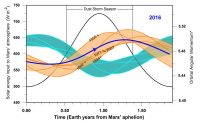Two 2001 images from the Mars Orbiter Camera on NASA’s Mars Global Surveyor orbiter show a dramatic change in the planet’s appearance when haze raised by dust-storm activity in the south became globally distributed. The images were taken about a month apart. (NASA/JPL-Caltech/MSSS)
Home Two 2001 images from the Mars Orbiter Camera on NASA’s Mars Global Surveyor orbiter show a dramatic change in the planet’s appearance when haze raised by dust-storm activity in the south became globally distributed. The images were taken about a month apart. (NASA/JPL-Caltech/MSSS) Two 2001 images from the Mars Orbiter Camera on NASA's Mars Global Surveyor orbiter show a dramatic change in the planet's appearance when haze raised by dust-storm activity in the south became globally distributed. The images were taken about a month apart. (NASA/JPL-Caltech/MSSS)



